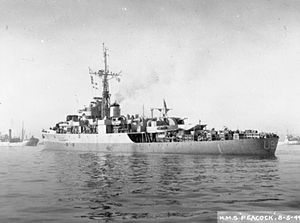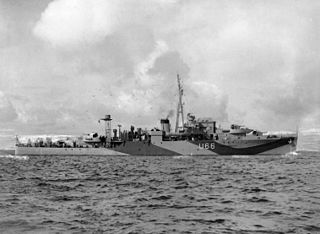
HMS Starling, pennant number U66, was a Modified Black Swan-class sloop of the Royal Navy. She was active in the Battle of the Atlantic during the Second World War and was the most successful anti-submarine warfare vessel of the Royal Navy, being credited with the destruction of fourteen U-boats.
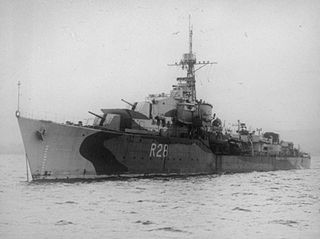
HMS Verulam was a V-class destroyer of the British Royal Navy that saw service during the Second World War.

HMS Termagant was a T-class destroyer of the Royal Navy that saw service during the Second World War. She was built by William Denny and Brothers, of Dumbarton and launched on 22 March 1943. She was scrapped in 1965.

HMS Magpie, pennant number U82, was a Royal Navy Modified Black Swan-class sloop launched in 1943 and broken up in 1959. She was the seventh Royal Navy ship to bear the name. She was reclassified as a frigate in 1947, receiving a new pennant number F82. The ship was the only vessel commanded by Prince Philip, Duke of Edinburgh, who took command on 2 September 1950, when he was 29.

HMS Mermaid was a Modified Black Swan-class sloop of the Royal Navy. Mermaid saw service as a convoy escort during the Second World War, taking part in the sinking of two German submarines while escorting Arctic convoys to and from the Soviet Union.

HMS Keppel was a Thornycroft type flotilla leader built for the Royal Navy at the end of the First World War. She was completed too late to serve in that conflict, but saw extensive service in the inter war years and in World War II. She was an effective convoy escort and U-boat killer, being credited with the destruction of five U-boats during the Battle of the Atlantic. She was the second of three ships named for 18th century Admiral Augustus Keppel.

The eighth HMS Worcester, was a Modified W-class destroyer of the British Royal Navy that saw service in World War II. She later served as an accommodation ship as the second HMS Yeoman.
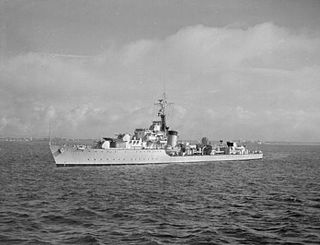
HMS Zephyr was a Z-class destroyer. She was launched on 13 July 1942 at Vickers-Armstrong on Tyneside and commissioned on 6 September 1944. She was 'adopted' by the civil community of Doncaster, replacing the destroyer HMS Lightning, which had originally been adopted during Warship Week in 1942.

HMS Obedient was an O-class destroyer of the Royal Navy. She was built by William Denny and Brothers of Dumbarton, between 1940 and 1942. During Warship Week in 1942 she was adopted by the civil community of Lymington, United Kingdom. She was scrapped in 1962.

HMS Pelican (L86) was an Egret-class sloop, built for the British Royal Navy. She was active during the Second World War and was a successful anti-submarine warfare vessel, being credited with the destruction of four U-boats.
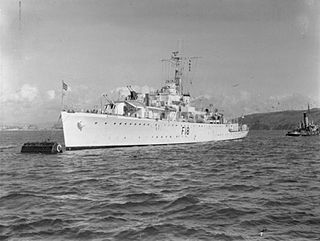
HMS Flamingo was a Black Swan-class sloop of the Royal Navy. She saw service as a convoy escort during the Second World War, seeing extensive service in the Mediterranean and Far East in 1945.

HMS Hart was a modified Black Swan-class sloop of the Royal Navy. She saw service as a convoy escort during the Second World War, seeing service in the Atlantic, Mediterranean and Far East in 1945. She also took part in the Korean War in 1950 and 1951.

HMS Alacrity was a modified Black Swan-class sloop of the Royal Navy. She was built for service as a convoy escort during the Second World War, but was completed too late to see action. She did subsequently take part in the Korean War between 1950 and 1952. She was scrapped in 1956.

HMS Sharpshooter was a Halcyon-class minesweeper of the British Royal Navy. Built at Devonport Dockyard, Sharpshooter was completed in 1937. She served through the Second World War, acting both in her designed role as minesweeper and as a convoy escort, escorting several Arctic convoys. She took part in the evacuation from Dunkirk in 1940, and sank the German submarine U-655 in 1942.

HMS Lark was a modified Black Swan-class sloop of the Royal Navy. She was laid down by Scotts Shipbuilding and Engineering Company, Greenock on 5 May 1942, launched on 28 August 1943 and commissioned on 10 April 1944, with the pennant number U11.

HMS Hind was a modified Black Swan-class sloop of the Royal Navy. She was laid down by William Denny and Brothers, Dumbarton on 31 August 1942, launched on 30 September 1943 and commissioned on 11 April 1944, with the pennant number U39.
HMS Opossum was a modified Black Swan-class sloop of the Royal Navy. She was laid down by William Denny and Brothers, Dumbarton on 28 July 1943, launched on 30 November 1944 and commissioned on 16 June 1945, with the pennant number U33.

HMS Cygnet was a modified Black Swan-class sloop of the Royal Navy. She was laid down by Cammell Laird, Birkenhead on 30 August 1941, launched on 28 July 1942 and commissioned on 1 December 1943, with the pennant number U38.

HMS Redpole was a modified Black Swan-class sloop of the Royal Navy. She was laid down by Yarrow Shipbuilders Limited, Scotstoun on 18 May 1942, launched on 25 February 1943 and commissioned on 24 June 1943, with the pennant number U69.
HMS Snipe was a modified Black Swan-class sloop of the Royal Navy. She was laid down by William Denny and Brothers, Dumbarton on 21 September 1944, launched on 20 December 1945 and commissioned on 9 September 1946, with the pennant number U20.
